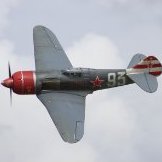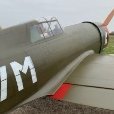-
Posts
8,783 -
Joined
-
Last visited
-
Days Won
36
Jon H last won the day on July 5
Jon H had the most liked content!
Recent Profile Visitors
The recent visitors block is disabled and is not being shown to other users.
Jon H's Achievements
1.9k
Reputation
-
They fly fine on 180 lasers, so any 30cc 4 stroke should do the job nicely. Its an interesting point actually as i have flown two near identical Spitfires from different brands on the laser 180 and they exhibited very different performance. One was a DB spit, 80 inch, about 23lbs i think and with the 180 in the nose. The other was a H9 30cc spitfire, also 80 inch, laser 180, but lighter at 18lbs if memory serves. Both flew nicely, but the heavier DB flew faster, landed slower, and was able to hold on to its energy better than the H9. I suspect its an airframe drag thing and the DB models seem very efficient. My DB Hurricane is hauled along with ease by its 240v, where as my slightler smaller and lighter sea fury from yt needs all of its 360v. In any case, 30cc will be plenty for the spitfire, and 20-21lbs should be your target flying weight.
-
errr...bad. Glow plug engines do not need constant glow support like this and it can be extremely detrimental to their performance as well as making them impossible to tune. Glow drivers are only intended for use at idle and for starting, so its likely you have simply fried the units by massively exceeding their designed power on time. I recommend you set up the next one so you can switch it off completely, fully tune up the engine with it off, and then turn it back on at the bottom 10-20% of the throttle travel if you need it to keep the plugs lit. My OS 4 cylinder has no need for any glow support once running and i never loose cylinders. My ASP, Enya, Magnum and Laser twin cylinders are the same, and i have never had an issue with the saito 3 cylinder radials either. The only multi cylinder engine to give me trouble was an SC 5 cylinder radial, but it has such a collection of problems its not a great benchmark and it is awaiting another rebuild. I would also make sure you are using the right fuel (5% nitro and 7 or 8% oil in these i think if my memory is right) and then tune it up nicely with the glow off.
-
I was very shocked to see this news on facebook and initially assumed he had been lost in an accident, but reading on the facts came out. As he and i are more or less the same age it really did come as a shock.
-
There should be a little button on the receiver that you need to hold down to tell it go into bind mode
-
That guy also has a gyro on elevator i believe 😉
-
Straight cut means slow run too lean, stuttering stop too rich. Tweak 1/8 turn and go again. I would aim for 2000rpm on a 90 class 4 stroke as a top end for idle rpm. even 1800 should probably be ok. Dont bother, just crank it with the leccy starter and it will go. If not, this also points at a possible lean slow run.
-
Flight modes are a variation on the same theme and I can see their utility in this case. I don't think my tx has that ability, but I have never checked for it. One word of warning if you use flaperons with this setup is to not use excessive aileron inputs. This flap mix idea puts the wing maybe at maybe 85 or 90% of its critical angle of attack, beyond which it will stall. If you lower an aileron, you increase the angle of attack on that wing and you may provoke a stall if you are this close to the critical aoa. It's for this reason I am not a fan of flaperons and have in the past cut a strip aileron into separate flap/aileron parts For your extra, if it's coming in like a rocket check the cg, it might be nose heavy. Most kits recommend a very conservative cg and significant amounts of weight can often be removed. I took over 1lb, or just under half of the total ballast out of my db hurricane and I can still stand to go a little more. Don't be scared. Unless it's miles out a tail heavy model is no bother to fly provided you don't also have massive rates. In fact a 'tail heavy' warbird is great as it won't spend it's life sniffing the dirt
-

SC Engines are back! .15 AP Hornet to 64cc 5 Cyl Radial.
Jon H replied to Paul Marsh's topic in IC Engines
I have a 1996 vintage sc radial and the best I ever managed was about 25 flights before mechanical failure. I have rebuilt it about half a dozen times and I am yet to get satisfactory performance from it. On the subject of performance, it's down on your ft310 and even a 300v but is more than twice the weight. I do plan to have another go at getting mine going, and my older version is not as good as the more modern offerings no doubt. But it's still a chunk of change for unknown performance -

SC Engines are back! .15 AP Hornet to 64cc 5 Cyl Radial.
Jon H replied to Paul Marsh's topic in IC Engines
some have new hair and makeup (blue rocker covers) so that suggests a new run? that has to be a typo. Its only ('only') £1400 on the perkins site...unless.....nope, no collector ring included to make up the difference. Its a typo in my book as all of the other je prices are in line with the rrp perkins list -
You can make like easier with an elevator-flap mix. Even if the model has no flaps, you can set up this mix to retrim the model for landing. In the case of the 30-50cc class models i fly, dropping the gear and flaps turns the model into a lawndart as its trimmed for much higher speed and without all that drag of the gear below the c/g. I need substantial amounts of up trim in the mix to offset this. In your case you do not have quite as much of a trim change as i dont think the model you have has flaps (??) but even so, you can set the mix up anyway. The way i recommend you do it is to assign a flap channel somewhere on the radio even if it does nothing. Mix the elevator to it (most tx's have a dedicated function for this already) and set a small amount on the rate to make sure its all working before going for a flight to set it up. When you go for a fly leave the menu open on the tx, and then slow the model down at altitude. IF you know your radio well you can beep the buttons yourself, if not employ someone to beep them for you. Keep adding more up elevator to the mix until the model stalls. When it does, put the flaps up to disconnect the mix. Then knock 5% or so off the mix and you are done. Now, with 'flaps' down the model is perfectly in trim for a speed/angle of attack just under stall and it will now be impossible to stall it on approach provided you leave the elevator alone. If the model is going long throttle back, if its short add power. You should not really need to touch the elevators during the whole final approach phase. Just be careful though, if you dont do a formalised approach with a dedicated downwind, base, final layout and just rock up on final still virtually flat out slamming the flaps down will simply case the model to do a backflip as it will be out of trim. As my glider instructor told me when flying full size, you did the landing about 3 minutes ago, but only now did you touch down. A fully thought out and planned landing circuit broken into chunks where do do things (throttle back, gear down,flaps half, rates high, flaps full...etc) in a checklist type fashion makes life a great deal easier and you can feed the flaps in slowly as the speed comes off. FInally, rates/expo and c/g. I have mentioned before that most models (warbirds especially) fly with excess rates on them. This makes them sensitive in the air so expo is added which gives an undesirable response when trying to land. This is a bit backwards as you need to tame the rates first, and then add expo if you need it. I hardly ever use it as its just not needed most of the time. However If the model is nose heavy, which is also very common, it will need a higher elevator rate to prevent a nose over and this contributes to the whole cycle of events. The long story short here is that the landing is done long before your wheels touch the runway. This can be a few minutes earlier at the start of the landing circuit (right height, speed etc) or it can be the week before back in the shed when you took some lead out and tweaked your setup.
-

Your most unliked engine , petrol, glowor diesel.
Jon H replied to Engine Doctor's topic in IC Engines
20x16 at 4400rpm. I have a thread on it somewhere here. -

SC Engines are back! .15 AP Hornet to 64cc 5 Cyl Radial.
Jon H replied to Paul Marsh's topic in IC Engines
Knock at least 10% off all prices for shop prices. Nice they are back though. Prices are...fine? i mean leeds have a 52 4 stroke at £160, which seems decent. They dont seem offensively priced to me, and it will be interesting to see if the material quality has improved at all. It also means i might be able to source a part or two for a lawn darted 160 flat i have hidden in a drawer. -
Unusual issue that is most likely caused by over revving. If the engine is held at high throttle in a dive it may over rev and cause the valves to float a little. Not sure what revs you are getting, but you could try a bit more prop, favour 4 thou not 2 on valve clearance, take it a little easier in a dive etc. If you are really worried you can shim the head off the liner a little, which will rob a tiny bit of performance, or take a burr and gently modify the piston. If you do that be sure you remove any and all sharp edges or tool marks as you risk fatigue cracks if you dont. The twins run more advanced timing than the singles so are more prone to this happening but its pretty rare. Unless it happens alot (this damage could have been from only one instance in one dive) its not going to be a problem.
-

Your most unliked engine , petrol, glowor diesel.
Jon H replied to Engine Doctor's topic in IC Engines
I had a similar experience with my two RMX 40's. I changed over to twin ASP52's in the end. Although i am yet to fly it, i have been experimenting with an rcv120sp and believe half the problem is the props rcv recommended. To me, they had insufficient pitch and my testing so far seems to back up this idea. Once i get back to flying again i plan to fit the 120 in an old wot4xl and see how we get on. If you decided to experiment with yours use a minimum of 12 inches of pitch...something like 18x12 or 16x14 would be my choices after a little napkin maths -

Your most unliked engine , petrol, glowor diesel.
Jon H replied to Engine Doctor's topic in IC Engines
RMX40 2 stroke. Just trash The OS LA series. Liners fell apart after about 2 minutes. Never owned any, but all 2 stroke petrol engines as the sound is offensive 😉



.thumb.jpg.507e8e41f64a8a0ae8fbd699d456cbca.jpg)



